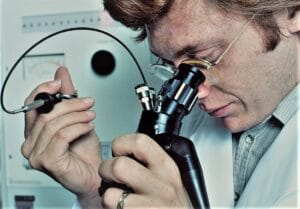 Endoscopes with disposable components, as well as fully disposable endoscopes, have been introduced recently to reduce the risk of contamination of endoscopes between procedures. A recent study looked at the quality of duodenoscopes with disposable elevator caps (DEC) to see how they performed when utilized by endoscopists who are used to utilizing traditional duodenoscopes.
Endoscopes with disposable components, as well as fully disposable endoscopes, have been introduced recently to reduce the risk of contamination of endoscopes between procedures. A recent study looked at the quality of duodenoscopes with disposable elevator caps (DEC) to see how they performed when utilized by endoscopists who are used to utilizing traditional duodenoscopes.
The study named the DECap trial, looked solely at the usability of the duodenoscopes from a clinical perspective, and not the reduction of infection risk. The multicenter trial followed 200 procedures using duodenoscopes with DECs and measured the level of satisfaction from the user perspective. As this article in Gastroenterology & Endoscopy News by Ted Bosworth explains:
“Although the devices were not compared with conventional duodenoscopes, the endoscopists appeared to find the performance characteristics comparable to those observed during past experiences with other devices. For 10 specific maneuvers, the endoscopists rated the scope’s performance as “met expectations,” “improvement needed” or “unsatisfactory.”
Evaluating the scope during the most performed maneuvers, such as ease of attempting cannulation or stone removal with bone sweep, 100% of participating endoscopists reported that the device met expectations. In a few cases, such as tip control and ability to examine the mucosa, less than 1% advised that improvement was needed, but no one considered performance to be unsatisfactory. Plastic stent placement was associated with the lowest level of satisfaction. For this maneuver, 3% of the endoscopists graded the device as “improvement needed.” Although this meant that 97% considered the device to have met expectations, the figure was lower than the 99% to 100% who concluded that expectations were met for the other nine maneuvers.
Nurses and technicians rated the overall performance of the modified duodenoscope for various preprocedural, intraprocedural and postprocedural tasks as 97% to 99%.
Ultimately, the hope is that the DEC will help reduce the vexing outbreaks of infection associated with contaminated duodenoscopes. These outbreaks have been reported even after duodenoscope processing had been considered adequate.
The source of the contamination, according to multiple studies and evaluations, has been parts of the device that are difficult to fully sterilize. The problem is significant. In a recent meta-analysis of 15 studies investigating contamination rates of reprocessed duodenoscopes, the rate of contamination was 15% (EClinicalMedicine 2020;25:100451). The rate of associated outbreaks was much lower, but the FDA, among others, has considered the risk to be unacceptably high and has been working to encourage scope manufacturers to resolve the problem.
Of duodenoscope parts that are susceptible to contamination, the elevator mechanism is among the most commonly implicated, according to a report issued by the FDA in November 2019 (https://www.fda.gov/ media/ 132187/ download). The goal of the cap is to eliminate this vulnerability.
Although the innovative design of the scope tested in the DECap trial “has the potential to reduce ERCP-related infectious outbreaks,” according to Thosani, this study provides only the first step toward reducing infection outbreaks associated with contaminated duodenoscopes.
More trials are coming. One, called ICECAP that is enrolling more than 500 patients, will randomly assign participants to undergo ERCP with a traditional duodenoscope or one with a disposable cap (BMC Gastroenterol 2020;20:64). The primary end point consists of persistent bacterial contamination after traditional automated reprocessing and ERCP technical success.
“Persistent microbial contamination rate is, at this point, the best end point we have in predicting the potential infection transmission risk of a duodenoscope,” said Nauzer Forbes, MD, the director of the therapeutic endoscopy training program at the University of Calgary, in Alberta, and lead investigator on the ICECAP trial. He acknowledged that persistent microbial contamination is “by no means a definitive end point,” but it is a practical end point.”
Read the entire communication here: Novel Scope With Disposable Elevator Cap Might Be Answer To Infection Risk ;
With the introduction of endoscopes with disposable parts, such as DECs, and even fully disposable endoscopes, many attempts are underway to reduce the likelihood of infections caused by poorly disinfected endoscopes. To ensure patient safety, hospitals must design a standard protocol that ensures maximum disinfection of endoscopes after each use – and these protocols must take into account the use of disposable components. Hospitals must also implement systems and processes that allow them to check that staff are following their protocols and documenting their steps for regulatory purposes, such as Joint Commission surveys. Endoscope tracking systems such as iRIScope can display the proper workflow for reprocessing endoscopes and document the individual steps automatically. Any breaches of protocol can be alerted in real-time to protect patients and identify which staff members need additional training on reprocessing techniques. You owe it to your staff and your patients to offer the peace of mind that endoscopes are being properly reprocessed every single time.
